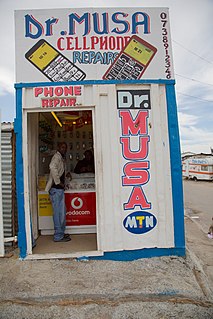Related Research Articles
Masaba (Lumasaaba), sometimes known as Gisu (Lugisu) after one of its dialects, is a Bantu language spoken by more than two million people in East Africa. The Gisu dialect in eastern Uganda is mutually intelligible with Bukusu, spoken by ethnic Luhya in western Kenya. Masaba is the local name of Mount Elgon and the name of the son of the ancestor of the Gisu tribe. Like other Bantu languages, Lumasaba nouns are divided into several sets of noun classes. These are similar to the genders in Germanic and Romance languages, except that instead of the usual two or three, there are around eighteen different noun classes. The language has a quite complex verb morphology.

The Abagusii are a highly diverse East African ethnic group and nation indigenous to Kisii and Nyamira counties of former Nyanza, as well as parts of Kericho and Bomet counties of the former Rift Valley province of Kenya. The Abagusii are unrelated to the Kisi people of Malawi and the Kissi people of West Africa, other than the three communities having similar sounding names.

The Luhya comprise a number of Bantu ethnic groups native to western Kenya. They are divided into 20 culturally and linguistically related tribes.
Bukusu is a dialect of the Masaba language spoken by the Bukusu tribe of the Luhya people of western Kenya. It is one of several ethnically Luhya dialects; however, it is more closely related to the Gisu dialect of Masaaba in eastern Uganda than it is to other languages spoken by the Luhya.
Mwami is an honorific title common in parts of Central and East Africa. The title means chief or tribal chief in several Bantu languages. It was historically used by kings in several African nations, and is still used for traditional kings or rulers of regions within several African nation-states.
Luhya is a Bantu language of western Kenya.

Nyanza Province was one of Kenya's eight administrative provinces before the formation of the 47 counties under the 2010 constitution. Six counties were organised in the area of the former province.
Vihiga is a town in Kenya located on the eastern side of the Kakamega Forest.

Kenya is a multilingual country. Swahili, a Bantu language, and English are widely spoken as lingua francas and serve as the two official languages. English was inherited from colonial rule. Including second-language speakers, there are more speakers of Swahili than English in Kenya.
Digo (Chidigo) is a Bantu language spoken primarily along the East African coast between Mombasa and Tanga by the Digo people of Kenya and Tanzania. The ethnic Digo population has been estimated at around 360,000, the majority of whom are presumably speakers of the language. All adult speakers of Digo are bilingual in Swahili, East Africa's lingua franca. The two languages are closely related, and Digo also has much vocabulary borrowed from neighbouring Swahili dialects.

The Maragoli, or Logoli (Ava-Logooli), are now the second-largest ethnic group of the 6 million-strong Luhya nation in Kenya, numbering around 2.1 million, or 15% of the Luhya people according to the last Kenyan census. Their language is called Logoli, Lulogooli, Ululogooli, or Maragoli. The name Maragoli probably emerged later on after interaction of the people with missionaries of the Quaker Church.
The Great Lakes Bantu languages, also known as Lacustrine Bantu and Bantu zone J, are a group of Bantu languages of East Africa. They were recognized as a group by the Tervuren team, who posited them as an additional zone to Guthrie's largely geographic classification of Bantu.
Dahl's law is a sound rule in some of the Northeast Bantu languages that illustrates a case of voicing dissimilation. In the history of these languages, a voiceless stop, such as, became voiced when immediately followed by a syllable with another voiceless stop. For example, Nyamwezi has -datu "three" where Swahili, a Bantu language that did not undergo Dahl's law, has -tatu, and Shambala has mgate "bread" where Swahili has mkate. Dahl's law is the reason for the name Gikuyu when the language prefix normally found in that language is ki-.
Nyala can refer to 2 different languages:
Nyole is a Bantu language spoken by the Luhya people in Vihiga District, Kenya. There is 61% lexical similarity with a related but different Nyole dialect in Uganda.
Samia (Saamia) is a Bantu language spoken by the Luhya people of Uganda and Kenya. Ethnologue includes Songa as a dialect, but it may be a separate language.

The Bantu peoples, or Bantu, are an ethnolinguistic grouping of approximately 400 distinct ethnic groups who speak Bantu languages. They are native to 24 countries spread over a vast area from Central Africa to Southeast Africa and into Southern Africa. There are several hundred Bantu languages. Depending on the definition of "language" or "dialect", it is estimated that there are between 440 and 680 distinct languages. The total number of speakers is in the hundreds of millions, ranging at roughly 350 million in the mid-2010s. About 60 million speakers (2015), divided into some 200 ethnic or tribal groups, are found in the Democratic Republic of the Congo alone.
Idakho, Isukha, and Tiriki are mutually intelligible Kenyan languages within the Luhya ethnic group. They are a set of languages closely related to some other Luhya ethnic groups like Maragoli, but less so in comparison to others, like Bukusu,Tachoni or Samia,
Marachi is a Bantu language spoken by the Luhya people of Kenya.
Khayo (Xaayo) is a Bantu language spoken by the Luhya people of Kenya.
References
- ↑ Logooli at Ethnologue (18th ed., 2015) (subscription required)
- ↑ Jouni Filip Maho, 2009. New Updated Guthrie List Online